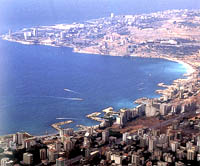Once a small quiet town, since the 1970’s Jounieh has grown into a densely built-up area of high-rise buildings, hotels and large resort complexes. Its beautiful bay, excellent restaurants, night spots and shopping attract visitors from all over.
To get a sense of Jounieh’s style, try strolling down the main street of the old town near the sea-front.

Driving
north
along
the
town’s
old
seacoast
towards
Maamaltein,
you
will
find
a
well-preserved
Roman
Bridge
across
the
River
Ghazir,
which
once
formed
the
boundary
between
the
Crusader
County
of
Tripoli
and
the
Latin
Kingdom
of
Jerusalem
In
Maamaltein
the
Casino
du
Liban
tempts
visitors
with
slot
machines,
American
Roulette,
Black
Jack,
Baccarat
and
Casino
Stud
Poker,
as
ell
as
restaurants,
a
theater
and
a
night
club.
Just
south
of
Jounieh,
Kaslik
has
its
own
special
identity
thanks
to
its
yacht
harbor,
beaches,
art
galleries,,
and
posh
restaurants.
The
yacht
harbor,
which
belongs
to
the
Automobile
and
Touring
Club
of
Lebanon,
has
space
for
about
100
boats
of
all
sizes,
with
room
for
visiting
yachts
as
well.
The
club
organizes
annual
car
rallies.
Less
than
one
kilometer
north
of
the
yacht
harbor
is
the
Shrine
of
St.
George.
Set
in
an
ancient
funerary
cave
known
as
Al-Batieh,
it
was
made
into
a
place
of
worship
and
Christian
pilgrimage
in
the
Middle
Ages.
Here
supplicants
light
candles
do
St.
George
and
the
Virgin
Mary,
or
bathe
in
the
waters
to
ensure
fertility.
This
is
also
the
traditional
site
of
St.
George’s
battle
with
the
dragon.
At
Sarba
above
Jounieh
is
the
Greek
Catholic
monastery
of
the
Holy
Savior.
It
was
built
in
1883
on
a
Mamluke
a
period
fortress,
which
itself
was
constructed
on
a
Roman
temple.
The
principal
monastic
building
rests
on
the
6
to
7-meter
walls
of
this
vast
Roam
temple
probably
dedicated
to
the
god
Serapis.
A
bas
relief
head
of
Apis,
the
Bull-go,
can
be
found
in
the
middle
of
the
north
wall
of
the
cella,
in
the
third
course
of
masonry.
It
faces
to
the
left,
not
outward.
The
original
temple
probably
had
a
subterranean
passage
through
the
cliff
to
the
grotto
of
St.
George,
far
below.
Nearby
Zouk
Mkayel
village,
although
swallowed
up
by
the
growing
metropolitan
area
of
the
capital,
still
preserves
its
old
town
center
with
traditional
houses.
Zouk
Mkayel
is
known
for
its
weaving,
including
brocades
and
traditional
stripes.
A
number
of
weaving
workshops
can
be
seen
in
the
town’s
old
souk,
an
attractive
traditional
street
restored
in
1995.
In
addition
to
artisanal
workshops,
there
are
cafes,
restaurants,
shops
and
terraces
overlooking
the
sea
and
mountains.
There
are
signs
at
the
approach
of
the
Souk,
located
about
10
minutes
up
the
mountain
from
the
coastal
highway.
In
Zouk
Mkayel,
they
also
make
delicate
almond
marzipan
in
the
shape
of
flowers.
(BYBLOS - JEITA GROTTO - TRIPOLI - SIDON - ZAHLÉ - BAALBECK)
(THE CEDARS - TYRE - BEITEDDINE - AANJAR)
EGYPT - SYRIA - JORDAN